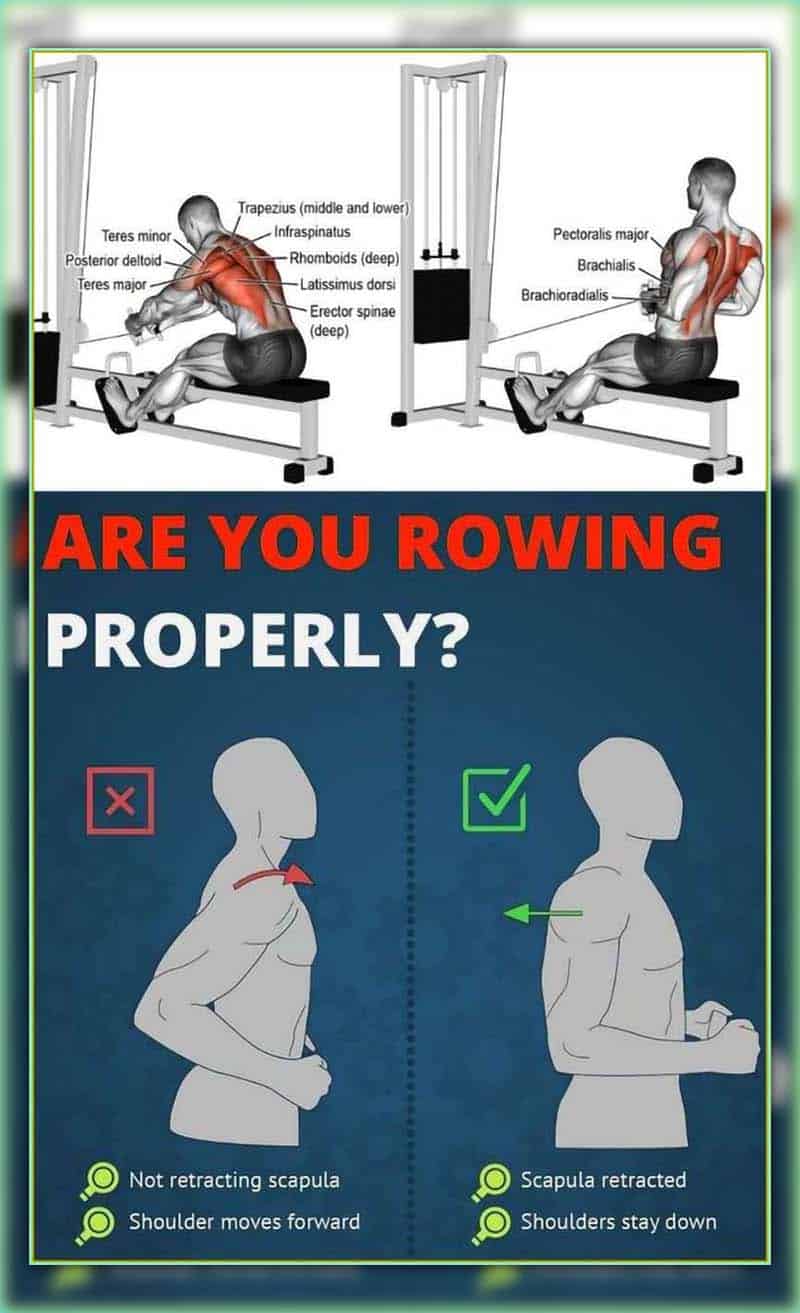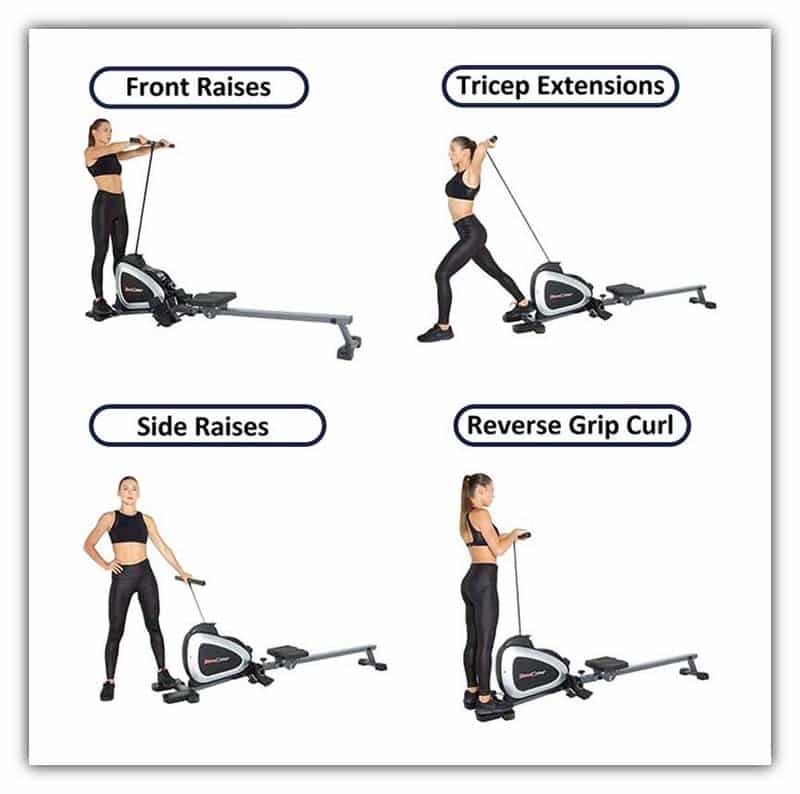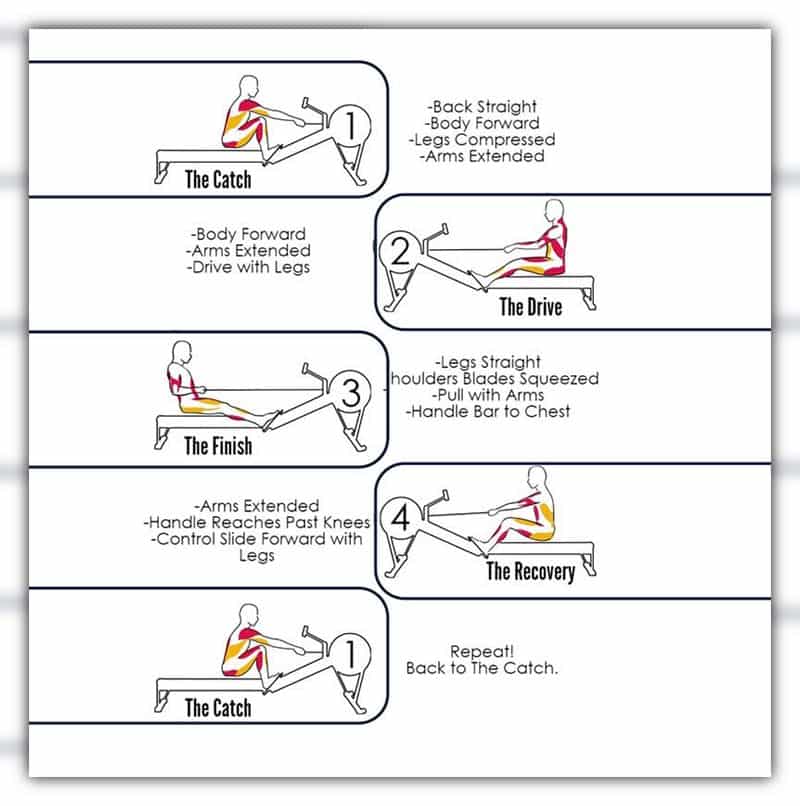
Harness the power of the rowing machine for weight loss and navigate your fitness journey with confidence. Our guide reveals the secrets behind this full-body workout dynamo.
Rowing Machine: An Overview

Experience transformative rowing machine for weight loss workouts that cater to your health and wellness objectives through these pivotal benefits:
Unlocking optimal calorie burn: While various workouts contribute to calorie burn, the rowing machine for fat loss stands out. It uniquely combines the benefits of aerobic, cardiovascular, and resistance training. The rower allows for intensive workouts in a shorter timeframe than many other gym machines. This makes rowing sessions a time-effective choice for those looking to maximize their fitness returns within tight schedules.

Prioritizing joint safety: A common concern with repetitive exercise is the risk of injury, which can disrupt your fitness journey. The design of the exercise rowing machine for home, however, offers a seated, low-impact workout. This reduces the strain on your joints, making it a safer alternative to even the best cushioned running machines. By using a rowing machine, you’re mitigating potential joint issues and ensuring longevity in your workout routine.
Enhancing stability and agility: The rowing machine for weight loss action strengthens both your lower-back and core muscles, foundational pillars for maintaining balance. As you build strength in these areas, you’ll find yourself more agile and capable of a broader range of movements.
Is Rowing Good for Weight Loss?

Yes. If you’re on the hunt for an effective weight loss tool, the rowing machine for weight loss is a stellar choice, offering a comprehensive workout for both your muscles and cardiovascular health. Its growing popularity in gyms and homes alike is a testament to its remarkable efficiency and user-friendliness.
Remarkably, rowing machine for weight loss engages about 86% of your body’s muscles, delivering noticeable results in sessions as brief as 15 minutes. For optimal benefits, aim for consistent 30-minute rowing sessions at least five times a week.
Over time, ramp up both the duration and intensity of your rowing machine for weight loss workouts, integrating varied intervals and increased resistance to keep pushing your limits. Always strive for a rhythm that’s brisk yet allows for light conversation, ensuring a balanced effort.
Burned Calories When You Using a Rowing Machine for Weight Loss

The data depict calorie burn rates for individuals of different weights during rowing machine for weight loss sessions of varying intensities, specifically “Moderate” and “Extreme”. Here’s a clearer representation of this information:
For a 15-minute session/1-hour session based on body weight and exercise intensity:
| Body Weight | Moderate Intensity | Extreme Intensity |
| 135 lb (61 kg) | 106/428 | 161/642 |
| 145 lb (66 kg) | 115/460 | 173/690 |
| 155 lb (70 kg) | 123/492 | 185/738 |
| 165 lb (75 kg) | 131/523 | 196/785 |
| 175 lb (79 kg) | 139/555 | 208/833 |
| 185 lb (84 kg) | 147/587 | 220/881 |
| 195 lb (88 kg) | 155/619 | 232/928 |
| 205 lb (93 kg) | 163/650 | 244/976 |
| 215 lb (98 kg) | 171/682 | 256/1023 |
| 225 lb (102 kg) | 179/714 | 268/1071 |
| 235 lb (107 kg) | 187/746 | 280/1119 |
| 245 lb (111 kg) | 194/777 | 292/1166 |
For those considering rowing machine for weight loss as an exercise, this chart provides a useful reference to estimate potential calorie burns based on weight and workout intensity. As always, individual results can vary, and it’s a good idea to consult with a fitness professional to tailor workouts to individual needs.
Rowing Machine for Fat Loss: Exercies

Warm-up:
- 5-minute easy-paced row
- Rest for 1 minute
Workout:
- Set 1:
- Row with intensity for 40 seconds
- Rest for 20 seconds
- Repeat for 5 rounds
- Set 2:
- Perform reverse lunge to bicep curl x10
- Follow with squat to shoulder press x10
- Repeat for 3 rounds
- Tip: Use dumbbells to up the ante.
- Set 3:
- Sprint row for 30 seconds
- Rest for 30 seconds
- Repeat for 5 rounds
- Set 4:
- Execute reverse lunge to bicep curl x10
- Then, squat to shoulder press x10
- Go through this for 3 rounds
- Enhancement: Incorporate dumbbells for added resistance.
- Set 5:
- Intense row for 20 seconds
- Recover for 40 seconds
- Complete 5 rounds
Cool Down:
- Wind down with a 3-minute gentle row
Pro Tip on Rowing Technique: During the rowing sequence, the general order of motion is:
- For the catch, drive, and finish phases: legs first, followed by the back, and then the arms.
- During the recovery phase: start with the arms, then the back, and finally the legs.
Adhering to this technique ensures efficient movement and reduces the risk of injury. Always consider getting professional advice if unsure about your rowing form.
How to Use Rowing Machine for Fat Loss?
Prioritize Posture for Power: To truly activate your core and optimize your rowing machine for weight loss , posture is key. Ensure you’re sitting upright with your back straight. Elevate your chest, fix your gaze forward, and keep your chin elevated. This not only ensures efficient breathing but also enhances the efficacy of each rowing stroke.
Harness the Power of Your Legs: While use rowing machine for weight loss, the thrust should majorly come from your legs. This engages primary muscles like your glutes and increases calorie burn. Commonly, individuals rely heavily on their upper body. But, for optimal results, remember this distribution: 60% leg power, 20% arms, and 20% from your core and back.

Incorporate Power Stroke Intervals: Post warm-up, integrate three sets of power strokes – these quick, forceful strokes significantly boost calorie burn. The key is to maintain a consistent rhythm but amplify your force. For instance, initiate with 10 power strokes at 24 strokes per minute, followed by 10 lighter strokes. Progress by increasing the rate for subsequent sets. Incorporating High-Intensity Interval Training (HIIT) methods can further elevate your calorie burn. Ensure you cool down post such workouts.
Embrace Endurance Training: Though HIIT is potent, don’t underestimate the power of sustained, moderate-intensity rowing, often termed steady-state rowing. Target about 85% of your maximum heart rate and maintain a medium-paced row, perhaps 26 strokes per minute, for around 8-10 minutes. This method can be a game-changer in your calorie-burning journey.
Diversify Your Rowing Regimen: The human body is adaptable; repeating the same routine can make your workouts less effective over time. The trick? Keep your body on its toes! Alternate between short, intense HIIT sessions and longer, endurance-focused rows. This variation ensures continuous progress and prevents workout plateaus.
FAQs
Can you lose belly fat on a rowing machine?
Yes. Rowing is a comprehensive low-impact workout that can help increase heart rate and burn belly fat.
Is 30 minutes of rowing enough for weight loss?
Yes, 30 minutes of rowing can promote weight loss, especially when combined with consistency and regular sessions.
Is rowing better than cycling for fat loss?
Rowing, especially when used for HIIT workouts, has an after-burn effect, burning more calories post-workout compared to cycling. Thus, HIIT rowing can be more effective for fat loss than cycling.
Why am I not losing weight rowing?
Lack of variety might be the issue. Simply rowing the same 5km regularly might not be sufficient for weight loss. Incorporate high-intensity interval training, pyramid workouts, or speed sessions for better results.
Can you get in shape by just rowing?
Yes, consistent rowing can enhance your strength, stamina, and even lead to muscle development.
Is it OK to row every day?
Yes, daily rowing is feasible. However, it’s wise to alternate between intense and light sessions.
Is rowing better than treadmill for weight loss?
For purely fat loss, treadmills might edge ahead. But for a holistic approach including muscle building and overall fitness, rowing machines are superior.
Do you gain weight when you start rowing?
Rowing doesn’t necessarily guarantee weight loss. While some shed pounds, others might gain, especially if muscle mass increases. Consistent rowers who lose weight generally maintain their new weight if they persist with their regimen.
Does rowing burn back fat?
Rowing is a high-intensity exercise that targets the back and burns calories, contributing to overall fat loss.
Should you be fast or slow on a rowing machine?
Rowing at lower stroke rates helps in refining technique. As this technique becomes habitual, it can then be effectively applied at faster rates.

Wrapping up
In wrapping up, the rowing machine for weight loss stands out as a remarkable tool, combining both cardiovascular and muscle-strengthening benefits. Its holistic approach ensures that you not only shed those extra pounds but also tone up, making it a favored choice for many fitness enthusiasts.
If you found this guide insightful, don’t stop here! Check out into our fitness treasure trove at Bodyfitnt, where we have a plethora of information awaiting your discovery. Let’s row towards a fitter future together!

Born on July 26, 1960, Professor Tim Olds is a leading authority in the field of health sciences, focusing on exercise science, nutrition, and well-being. As the Bradley Distinguished Professor at the University of South Australia, his research offers pivotal insights into the effects of physical activity, diet, and lifestyle on health outcomes for both men and women.
Having completed two PhDs, one in French Studies and the other in exercise science, Professor Olds has uniquely blended his academic background to explore the multifaceted connections between human behavior, physical fitness, and nutrition. His work in mathematical modeling of cycling performance, anthropometry, and trends in fitness and fatness has informed strategies for weight management and healthy living.
Professor Olds served as the Project Director for the Australian National Nutrition and Physical Activity Survey, examining how diet and physical activity influence health on a national scale. His work on the ADAPT Project, focusing on 3D anthropometry, further showcased his innovative approach to understanding human physicality.
With numerous influential publications, Professor Olds has contributed substantially to the public’s understanding of diet, weight loss, and personalized fitness strategies. His findings have been instrumental in shaping health policies and behavioral change programs aimed at improving individual and community wellness.
From exploring women’s health concerns to understanding men’s fitness needs, Professor Olds’s research transcends gender barriers and offers a comprehensive view of the role of exercise and nutrition in enhancing life quality. His enduring commitment to health education and advocacy continues to inspire people to make informed decisions for a balanced and healthy life.
Professor Tim Olds’s trailblazing work stands as a vital resource for anyone interested in embracing a healthier lifestyle, understanding the science of physical activity, or pursuing effective strategies for diet and weight loss. His academic excellence and practical wisdom make him an essential voice in the ongoing conversation about health and well-being in the modern world.
PUBLISHED ARTICLES
- Olds, T. (2012). Evidence for a Sugars-to-Mental Health Pipeline. Atherosclerosis Supplements, 13(4), 29-30.
- Olds, T., Maher, C., & Zumin, S. (2011). The evolution of screen time: What’s next? Journal of Physical Activity and Health, 8(2), 236-244.
- Olds, T., Ferrar, K., Schranz, N., & Maher, C. (2013). Obese adolescents are less active than their normal‐weight peers, but wherein lies the difference? Journal of Adolescent Health, 53(6), 768-774.
- Olds, T., Maher, C., & Matricciani, L. (2010). Sleep duration or bedtime? Exploring the relationship between sleep habits and weight status and activity patterns. Sleep, 33(12), 1576-1581.
- Olds, T., Ridley, K., & Dollman, J. (2006). Screenieboppers and extreme screenies: The place of screen time in the time budgets of 10–13 year‐old Australian children. Australian and New Zealand Journal of Public Health, 30(2), 137-142.
These published articles reflect Professor Tim Olds’ contributions to various aspects of physical activity, sedentary behavior, and health-related research. They provide insights into the intricate relationship between lifestyle choices and health outcomes

